Northern Bering
and Chukchi
Seas 2007
Sir Wilfrid Laurier
![]()
Betty Carvellas Journal Entries
July 22, 2007
This will be my last journal as we are now waiting for the
helicopters to take people to shore. It seems very strange to be
sitting on board with nothing to do but wait. Even yesterday
people were out on deck at 5 in the morning using the underwater
camera. Our team was up early to sieve the rest of Jackie’s cores
and to pack. We had actually started packing the night before,
but it took all of yesterday, well in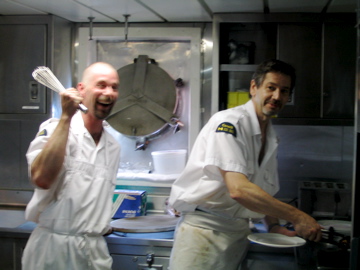 to
the evening, to get everything packed, labeled, and duct taped.
Rebecca and Lee went into Barrow to ship the samples (the most
important part!) back to the University of Tennessee while others
went in just to have a chance to see Barrow, the northern most
city in the United States.
to
the evening, to get everything packed, labeled, and duct taped.
Rebecca and Lee went into Barrow to ship the samples (the most
important part!) back to the University of Tennessee while others
went in just to have a chance to see Barrow, the northern most
city in the United States.
While we’ve been on board, the crew has been amazing; they always
seemed to be one step ahead of us to help out and to get things
done. While everyone’s work schedule varied from day to day and
people were working round the clock, one thing was always a
constant – the meals. Bert Boisseau and Rick
 Jakimchuk
produce three incredible meals each day, and everyone looks
forward to the amazing gourmet food, rich desserts, and
constantly available treats. When you’re on deck at night or
early in the morning, it’s such treat to come inside into the
crew’s mess and wrap your cold hands around a hot cup of coffee
or tea.
Jakimchuk
produce three incredible meals each day, and everyone looks
forward to the amazing gourmet food, rich desserts, and
constantly available treats. When you’re on deck at night or
early in the morning, it’s such treat to come inside into the
crew’s mess and wrap your cold hands around a hot cup of coffee
or tea.
It occurred to me that I haven’t included a pictures of myself in
any of my journals this year, so I’ve included a picture of our
mud team (with honorary member, Peter Lee) so you can tell that
I’ve really been on board. I’m right in the middle between
Rebecca and Peter. It’s been an amazing experience once again, to
be out here with this great group of people. It’s exhausting
work, but I’m very lucky to have the opportunity to participate
in such important, on-going research.
July 20, 2007
Yesterday turned out to be another long day (and night). We got
to our next to last full mud station at 2:45 PM. We knew it would
be a longer station because we were in deeper water (200 meters),
but we had no idea it would last nearly five hours. A big part of
the problem was that we were in an area with lots of rock and
gravel, and it made it very difficult to get a core or even a
grab. Once we finally finished, we moved on to our next station,
which started around 10 PM. This one was even deeper at 600
meters, and each time any equipment went down, it was a minimum
of ½ hour to come back up. We did two CTD casts and five van Veen
grabs before my work was done. At that point, Jackie still had
her cores to do, but she sent us to bed and stayed up on her own.
When I got up this morning, Jackie was still up because we had
moved to another station and she was working with the three box
cores that went down. When I woke up this morning at 9:30, she
was still on deck working!
While waiting for our work to begin last night, I talked with
Glenn Cooper, a research assistant and lab manager at the
University of Victoria. Glenn is working with the bongo nets
while on board. At nearly every station, Glenn and Orla Osborne
(I told you a little about Orla in my journal of July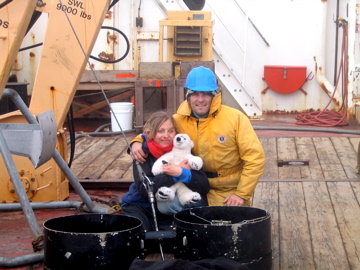 12), drop two large nets over the side and bring them back to the
surface vertically. The nets take two samples simultaneously and
capture zooplankton (tiny marine animals) in small filter bottles
(called cod ends) attached to the bottom of each net. Glenn and
Orla will rinse the nets once they come close to the ship to make
certain all the zooplankton are washed into the cod ends before
dumping the contents into buckets to be filtered and preserved.
Glenn told me that their work with the bongo nets involves two
projects. The first is to classify and quantify zooplankton for
the Institute of Ocean Sciences in Victoria. He preserves these
samples in formalin, which preserves their structure in order to
study species distribution and population size. He’ll preserve
other samples in ethanol to study population genetics. Using
genetic analysis, scientists can trace the distribution of
genetically distinct populations within a single species. By
doing so, they can track the dispersal of populations as currents
move through the Bering Sea and into the Arctic Ocean. Lastly,
Glenn and Orla are also collecting water from the CTD cast at the
same depths as their sample collection. Their goal is to measure
copepod (the type of zooplankton they are finding) productivity.
They’ll measure an enzyme, chitiobiase, which is released by the
copepods when they molt. Research has demonstrated that you can
relate the amount of enzyme in the water to the growth of the
copepods and therefore estimate the bioproductivity. Glenn and
Orla incubate the samples for 24 hours and take sub samples over
that time period in order to measure the change in the enzyme’s
activity. They’ll return the samples to the University of
Victoria for analysis.
12), drop two large nets over the side and bring them back to the
surface vertically. The nets take two samples simultaneously and
capture zooplankton (tiny marine animals) in small filter bottles
(called cod ends) attached to the bottom of each net. Glenn and
Orla will rinse the nets once they come close to the ship to make
certain all the zooplankton are washed into the cod ends before
dumping the contents into buckets to be filtered and preserved.
Glenn told me that their work with the bongo nets involves two
projects. The first is to classify and quantify zooplankton for
the Institute of Ocean Sciences in Victoria. He preserves these
samples in formalin, which preserves their structure in order to
study species distribution and population size. He’ll preserve
other samples in ethanol to study population genetics. Using
genetic analysis, scientists can trace the distribution of
genetically distinct populations within a single species. By
doing so, they can track the dispersal of populations as currents
move through the Bering Sea and into the Arctic Ocean. Lastly,
Glenn and Orla are also collecting water from the CTD cast at the
same depths as their sample collection. Their goal is to measure
copepod (the type of zooplankton they are finding) productivity.
They’ll measure an enzyme, chitiobiase, which is released by the
copepods when they molt. Research has demonstrated that you can
relate the amount of enzyme in the water to the growth of the
copepods and therefore estimate the bioproductivity. Glenn and
Orla incubate the samples for 24 hours and take sub samples over
that time period in order to measure the change in the enzyme’s
activity. They’ll return the samples to the University of
Victoria for analysis.
I also had a chance to talk yesterday with Michael Bentley, a
contractor from Victoria. When I asked Michael to describe his
role on board, he replied, “birdman.” Whenever the ship is
steaming, Michael is in the wheelhouse watching for birds and
marine mammals. He surveys an area 300 meters wide on one side of
the ship in order to do an inventory of the birds. He not only
records species and numbers, but also other information including
flight direction, general behavior, and plumage. He tries to
determine if anything in the local area is influencing the birds’
behavior such as being attracted to the ship or associated with
marine mammals. For example, we saw 13 gulls on the ice flow with
the polar bear yesterday. Although he’s seen relatively few birds
for most of the trip, he did see an overwhelming number, 1000’s
per hour, near the Pribilof Islands. No one knows for certain,
but there are any number of reasons why so many birds might
gather in one spot. It could be related to the presence of
fishing boats or plentiful feed.
Although our ride into Little Diomede was rough and extremely
wet, Michael still carried his camera and lenses. Little Diomede
is home to a large breeding colony of three species of auklets
(least, crested, and parakeet), and Michael wanted pictures of
the auklets and other birds he might find on the island. So far,
the most interesting bird he’s seen on the trip is a short tailed
albatross which he saw as the ship moved through Unimak Pass near
Dutch harbor. All of the data that Mike collects will go to the
Canadian Wildlife Service. Mike loves being on the ship and loves
his job. He came to the Laurier only 45 hours after a 31-day
cruise on the Canadian Coast Guard ship, John P. Tully.
July 19, 2007
Today has already started exceptionally well. For one thing, it’s
beautifully sunny and we’re surrounded by blue water loaded with
ice floes. Early this morning the ship stopped to let everyone
get a look at several walrus quite close to the ship. Then, to
top it off, just as we were stopping for a station, someone on
the bridge spotted a polar bear asleep on an ice floe very close
by. Everyone rushed to get binoculars and cameras while the bear
slept. Once the ship turned and it got wind of us, it woke up,
looked right at us, and gave everyone a great view for about 15
minutes before it slipped into the water. Sun, ice, walrus, and a
polar bear – not a bad way to start the day!

As we’re nearing the end of the cruise, it’s time to tell you
about the rest of the science going on board and about those who
are working with it. Doug Anderson is an instrumentation
technician with the Institute for Ocean Sciences (IOS) in
Victoria. I’ve already told you about the CTD bottle rosette;
it’s Doug’s job to look after the CTD and to do dissolved oxygen
titrations using an automated system. Although this is his first
trip to the Artic, he’s been doing this work for a decade,
spending about three months each year on board a ship. Sometimes
it’s hard to remember how many stations we’ve done, so I asked
Doug how many CTD casts would be completed by the end of the
trip. He thought there would be a total of 50 – 60 casts, all in
less than three weeks. Doug told me that he’s very glad to have
all the volunteers on board to check the accuracy of the sampling
and the data entry.
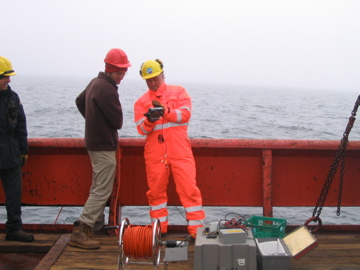 Will
Burt is entering his last year of undergraduate work at the
University of Victoria, working toward a degree in geoscience.
This summer, he’s been working on a condensed ocean science
minor, and he’s thinking of eventually going on to a PhD in
geochemical or physical oceanography. Will has been out once
before, on the Louis St. Laurent two years ago, but he feels he
has more responsibility on this cruise. He’s not only been
operating the CTD and learning how to process the data, but he’s
working with the underwater camera. At most of the shallow
stations (the camera has about 130 meters of cable), someone (its
usually Will, Marcus, or Phil working with the camera) lowers the
camera over the side while another person checks the temperature
and depth data and watches the two lasers which are mounted on
the camera. The lasers are used for scale, to provide light, and
to “see” where the bottom is. The fifteen minutes of video from
each station will go back to the University of Tennessee and to
IOS, but people are working to do rough editing for those on
board to watch. The camera has been running at all of the shelf
stations (the shallow area near the coast), and everyone is
enjoying the great views of the organisms on the bottom. Jackie
really likes having the camera because it gives her an idea of
what we’ll find in the grabs and cores.
Will
Burt is entering his last year of undergraduate work at the
University of Victoria, working toward a degree in geoscience.
This summer, he’s been working on a condensed ocean science
minor, and he’s thinking of eventually going on to a PhD in
geochemical or physical oceanography. Will has been out once
before, on the Louis St. Laurent two years ago, but he feels he
has more responsibility on this cruise. He’s not only been
operating the CTD and learning how to process the data, but he’s
working with the underwater camera. At most of the shallow
stations (the camera has about 130 meters of cable), someone (its
usually Will, Marcus, or Phil working with the camera) lowers the
camera over the side while another person checks the temperature
and depth data and watches the two lasers which are mounted on
the camera. The lasers are used for scale, to provide light, and
to “see” where the bottom is. The fifteen minutes of video from
each station will go back to the University of Tennessee and to
IOS, but people are working to do rough editing for those on
board to watch. The camera has been running at all of the shelf
stations (the shallow area near the coast), and everyone is
enjoying the great views of the organisms on the bottom. Jackie
really likes having the camera because it gives her an idea of
what we’ll find in the grabs and cores.
July 18, 2007
I first worked with Dr. Jackie Grebmeier when I was a participant
in the TEA (Teachers Experiencing Antarctica and the Arctic)
program in 2002. I was on a 6-week cruise on the US Coast Guard
Cutter Healy then, but I’ve now been back to the Arctic with
Jackie on the Sir Wilfrid Laurier summer cruise four times. If
you’ve been reading my journals, you probably understand that a
science research cruise doesn’t fit the definition most have for
the word “cruise.” Work goes on round the clock for the entire
time we’re out. I find it tiring, but I know it’s only for two
weeks. Jackie, however, came to the Laurier from a 34 day cruise
on the Healy, which ended only 14 days before this one began.
Jackie told me that, even though the hours are long and hard when
out here, she enjoys this time because she spends so much time
with lab and paper work while at home at the University of
Tennessee, Knoxville. She’s particularly excited to be on the
Laurier cruise this year because it’s the International Polar
Year (IPY), and her program is part of the C30: Canada’s Three
Oceans program.
Jackie’s work involves the study of benthic organisms (those that
live on the bottom) and the characteristics of their environment.
She’s trying to understand the role these organisms play in the
cycling of carbon, the element found in all living things and, of
course, in carbon dioxide, the gas we hear so much about in
relation to global climate change. We’ve already completed our
sampling in three “hot spots,” areas where Jackie has sampled
since 1984. She samples these areas because the water is shallow
and most of the organic carbon in the water column makes it way
to the sediments. Jackie looks at the carbon supply to the
sediments, recycling of carbon in the sediments, and the
community structure of the invertebrate macrofauna (“large”
animals without backbones). These three areas are also important
to top predators such as the spectacled eider (a threatened
population of diving sea ducks), walruses, and gray whales that
all feed on the animals in the sediments.
Over the last 23 years, Jackie has seen a decline in the
population of the dominant invertebrate animals in these areas.
The changes seem related to changes in sea ice, water
temperature, current flow, and carbon supply. For example, the
population of amphipods (small shrimp-like crustaceans) has
declined in the Chirikov Basin and the gray whales that feed on
them have had to move north in search of food. Another example is
the shift in abundance of certain species of clams. Since clams
are a major food source for both walruses an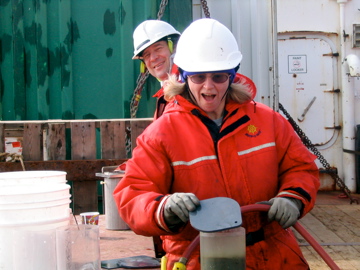 d
the spectacled eider, they are a critical part of the ecosystem.
The spectacled eider dives up to 60 meters to feed on clams, and
the tellinid clam is a favorite because it’s meaty and has a soft
shell. With the changing environment, the tellinid population has
declined and the population of the nuculanid clams (tougher
shells and less meat) has increased, making it tough for the
eiders to find enough food.
d
the spectacled eider, they are a critical part of the ecosystem.
The spectacled eider dives up to 60 meters to feed on clams, and
the tellinid clam is a favorite because it’s meaty and has a soft
shell. With the changing environment, the tellinid population has
declined and the population of the nuculanid clams (tougher
shells and less meat) has increased, making it tough for the
eiders to find enough food.
Check out the picture of Jackie with her core to see what she is
looking for in a “good” core. It should be about ¾ full of
relatively undisturbed mud with water over it. Once she has her
two good cores from a station, Jackie will carry them back to the
lab on board to conduct 8–18 hour respiration experiments. By
allowing the organisms to remain in their “natural” environment
she can study total community metabolism. When she’s done, we
sieve the cores and preserve the organisms for later analysis.
July 17, 2007
I’m going to use “today’s” (I admit, I’m writing this on the
18th) journal to tell you a bit about each of the people on our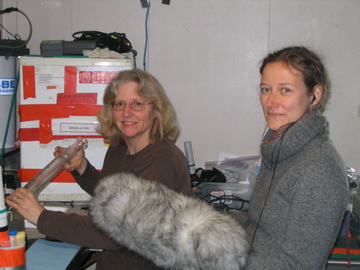 “mud team.” I’ve already told you about Corrine Warren in my
journal from July 12, and her picture was posted with yesterday’s
journal. Another person working with us is Monika Seynsche, a
reporter with German public radio. Monika is posting her reports
and photographs every two days. While I have the luxury of
getting behind a bit when we get very busy, Monika is held to a
strict schedule. So, as we’ve been doing all of these
back-to-back stations, some through the night and into the day,
Monika has also been interviewing the scientists on board and
writing and posting her reports. She tells me that, although she
finds the mud work exhausting, the routine of our work on deck is
a nice break from the “mind work” of writing.
“mud team.” I’ve already told you about Corrine Warren in my
journal from July 12, and her picture was posted with yesterday’s
journal. Another person working with us is Monika Seynsche, a
reporter with German public radio. Monika is posting her reports
and photographs every two days. While I have the luxury of
getting behind a bit when we get very busy, Monika is held to a
strict schedule. So, as we’ve been doing all of these
back-to-back stations, some through the night and into the day,
Monika has also been interviewing the scientists on board and
writing and posting her reports. She tells me that, although she
finds the mud work exhausting, the routine of our work on deck is
a nice break from the “mind work” of writing.
It’s great to be working with Rebecca Pirtle-Levy again; this is
our fourth trip together on the Laurier. Rebecca has worked with
Jackie for seven years, first as an undergraduate, then as a
Masters Degree student/research assistant, now as a technician.
Just prior to this cruise, Rebecca was with Jackie on the US
Coast Guard Cutter Healy on a six-week cruise in the Bering Sea.
She’ll be anxious to get home after this one! While my work with
Jackie only happens at mud stations, Rebecca’s work is much more
extensive. Whenever the CTD goes into the water, Rebecca collects
water from the bottles for chlorophyll-a analysis and for
nutrients. It’s the chlorophyll-a that takes the extra time on
board; the nutrients are preserved for later analysis.
Chlorophyll-a is found in the cells of plants and is an important
indicator of productivity, the availability of food in the water.
After filtering the water, she places the filters into the
freezer to break open the plant cells and release the pigments.
To extract the chlorophyll-a, she will then place the filters in
acetone in the refrigerator. At the end of twenty-four hours,
Rebecca takes chlorophyll-a measurements using a fluorometer. She
also takes readings from the mud samples from the van Veen grab.
Once we’ve been underway a while, the samples back up and someone
has to be up every two hours for reading and, if we’re at a
station, to do mud work and collect more water.
Dr. Lee Cooper, from the University of Tennessee, Knoxville,
often helps Rebecca with the readings in addition to helping out
when we’re on deck. However, one of his other interests is
collecting water for oxygen-18, an isotope (different form of the
same element) of oxygen. By analyzing the ratio of between
oxygen-18 and oxygen-16 (another isotope of oxygen), Lee can
track the fresh water component of the water he’s sampling. As
the Japanese current, Kuriosho, comes across the Pacific, it
splits upon reaching the coast of North America. It heads south
to California and then north to become the Alaskan current that
runs along the southern coast of Alaska and the Aleutian islands.
As it reaches the passes through the Aleutians, the current runs
north in the Bering Sea. Lee should be able to tell, in general
terms if the components of the fresh water are from Japan or from
the rivers, glaciers, and melting snow of Alaska or from both.
The farther north, the colder the temperature, the higher the
altitude at which the precipitation fell, the more depleted the
oxygen-18. His data can help determine the amount of fresh water
coming from Alaska, from melting glaciers or from melted sea ice
for example, and therefore provide information about water masses
in the study area and fresh water transfer into the Arctic.
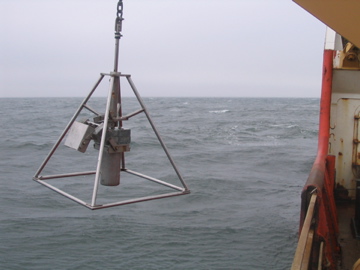 OK,
it’s time to tell you what happens at a mud station. I sent some
pictures of the van Veen work yesterday and will add pictures of
the work with the Haps core today. Once the CTD is out of the
water, we go out on deck to get five van Veen grabs and three
good cores. In theory, that means the winch lowers the equipment
eight times, but it actually might be more if mud conditions
aren’t good or the cores don’t look just right. If you follow
along with the pictures posted yesterday, you can get an idea of
our work with the van Veen grab that we use to go to the bottom
to scoop up mud. The first time it comes on deck, someone takes
samples off the top (we open a little door to remove mud from the
very surface) for TOC (total organic carbon), sediment
chlorophyll analysis, and HPLC (high performance liquid
chromatography), a technique used to separate different
photosynthetic pigments in the phytoplankton. These pigments vary
by phytoplankton group, so HPLC can tell us which groups
contributed which proportion of the organic materials in the
sediments. We also fill a Marinelli beaker with mud that Lee will
take back to analyze for Beryllium-7 and Cesium-137 to determine
the rate of sedimentation and/or areas where there has been
recent deposition. By analyzing these sub samples Jackie gets
information about the phytoplankton and how long it has taken to
reach the sediments, the forms of carbon and how much of it
arrives at the sediment surface from the processes taking pace in
the overlying water column, and the types of organisms in the
mud. Analysis of the grain size yields an indicat
OK,
it’s time to tell you what happens at a mud station. I sent some
pictures of the van Veen work yesterday and will add pictures of
the work with the Haps core today. Once the CTD is out of the
water, we go out on deck to get five van Veen grabs and three
good cores. In theory, that means the winch lowers the equipment
eight times, but it actually might be more if mud conditions
aren’t good or the cores don’t look just right. If you follow
along with the pictures posted yesterday, you can get an idea of
our work with the van Veen grab that we use to go to the bottom
to scoop up mud. The first time it comes on deck, someone takes
samples off the top (we open a little door to remove mud from the
very surface) for TOC (total organic carbon), sediment
chlorophyll analysis, and HPLC (high performance liquid
chromatography), a technique used to separate different
photosynthetic pigments in the phytoplankton. These pigments vary
by phytoplankton group, so HPLC can tell us which groups
contributed which proportion of the organic materials in the
sediments. We also fill a Marinelli beaker with mud that Lee will
take back to analyze for Beryllium-7 and Cesium-137 to determine
the rate of sedimentation and/or areas where there has been
recent deposition. By analyzing these sub samples Jackie gets
information about the phytoplankton and how long it has taken to
reach the sediments, the forms of carbon and how much of it
arrives at the sediment surface from the processes taking pace in
the overlying water column, and the types of organisms in the
mud. Analysis of the grain size yields an indicat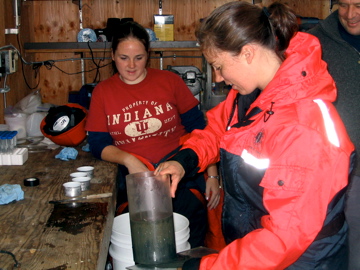 ion
of the speed of the current as well as the physical environment
the animals live in. For the next four van Veen grabs we’ll dump
the mud into sieve boxes with one-millimeter screens where we use
hoses to clear away the mud. We then preserve the organisms left
behind to get an idea of what’s living there and how it interacts
with the environment. Although the picture from yesterday showed
mostly clams, it’s not uncommon to find different worms, sea
anemones, brittle stars, snails, sand dollars, and amphipods
(small, shrimp-like crustaceans that are a major food source for
gray whales.)
ion
of the speed of the current as well as the physical environment
the animals live in. For the next four van Veen grabs we’ll dump
the mud into sieve boxes with one-millimeter screens where we use
hoses to clear away the mud. We then preserve the organisms left
behind to get an idea of what’s living there and how it interacts
with the environment. Although the picture from yesterday showed
mostly clams, it’s not uncommon to find different worms, sea
anemones, brittle stars, snails, sand dollars, and amphipods
(small, shrimp-like crustaceans that are a major food source for
gray whales.)
Once we have five good grabs, Jackie will send down the Haps core
to get a core sample of the bottom. She’s looking for two good
cores (undisturbed with a layer of seawater on the top) to use in
her respiration experiments. By allowing the organisms to remain
in their “natural” environment, Jackie can study total community
metabolism. (I’ll fill you in a bit more on Jackie’s work
tomorrow.) Rebecca takes the remaining core into the on-deck van
where she will cut it, taking one centimeter sections of the core
for the first four centimeters, and packing, canning, and
freezing the mud to take back for later analysis.
July 16, 2007
Last night was a long one as we did a series of stations across
the Bering Strait. They started at 9:30 PM and wrapped up around
7 this morning. Those who weren’t on shifts were up for the
entire time. I managed a few hours of sleep before waking to hear
an announcement that anyone wishing to go into Little Diomede
should report to the officers’ lounge for a briefing. We were
advised to wear gear appropriate for wet and very cold weather.
Two members of the crew spent several hours taking groups of five
or six at a time into shore in a rubber zodiac. Climbing over the
side of the ship and making our way down a rope ladder into a
rocking rubber boat was interesting! We were all very glad that
we had on our rain gear or mustang survival suits, as the ride
was rough and wet. It was well worth the trip to have a chance to
visit Little Diomede, a small island in the middle of the Bering
Strait. On a clear day, unlike today, you can see the Russian
island of Big Diomede in the distance. The US/Russian border runs
in the Bering Strait, right between the two islands. The entire
settlement of approximately 150 people takes up only a small area
of the rocky coast and, because the island is accessible only by
helicopter or boat, the community is subsistence based. The
people hunt beluga and bowhead whales, seals, walrus, and polar
bear, and they supplement their diet with fish, crab, local wild
greens and vegetables. I was happy to speak again with a woman I
had met last year, and she told me that the spring hunt was very
good this year; they have plenty of food set aside. Once we were
all on the island, our group gathered in the community
center/bingo hall for a show of traditional Eskimo singing and
dancing, accompanied by the sound of walrus skin drums. How
exciting to see and hear songs and dances that have been passed
down over countless generations!
Now that we’re back on board, our mud team is getting ready for a
long series of seven stations that will begin around 10 PM and
end sometime late tomorrow afternoon. Fortunately, it will be
light for most of that time; unfortunately, it’s been very foggy
and misty and it’s difficult to get good pictures. But, since
this is the work I do on board, I’m going to be taking lots of
pictures tomorrow when it will hopefully be better weather.
OK – I admit that it is now 3:25 PM on Tuesday, the 17th. Once we
started the line of stations last night, we were almost finished
the third station at 6 AM when all work stopped due to bad
weather. The decision to stop and wait for the weather to improve
provided a respite for all who were longing for a few hours of
uninterrupted sleep. The weather did improve and we’ve been out
on deck most of the day starting at 11 AM.
I haven’t explained Jackie’s work to you yet, but I’m going to
include a few pictures along with this journal entry. I’ll try to
tell you about Jackie’s work and include the remainder of the
pictures with today’s journal. I have lots!
Note: I’m almost certain that “today’s" journal will be posted
tomorrow. Once this series of stations is complete, I plan to
catch up on some much needed sleep. It’s interesting to be on
board a ship where science is taking place. There’s something
happening 24/7, either on deck, by the CTD, in the lab, or at
someone’s computer. Combined with almost 24-hour daylight, it
makes it tough to remember the day of the week or when you’ll
have to be ready for your next job.
July 15, 2007
Philippe B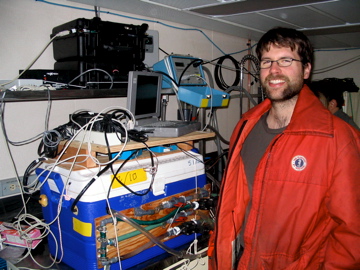 enoit,
a PhD student in physical oceanography at the University of
Victoria, is another member of the science team. He’s actually
running three experiments while on board. The first is (or
rather, it was) a bio acoustic “fish”, a piece of equipment
that’s towed over the side while the ship is underway. It emits
high frequency sound waves to detect the backscatter of biomass
in the water. Unfortunately, the high speed of the ship seemed to
be too much for the fish, which ended up flying out of the water,
or into the ship’s hull, instead of just under the surface. It’s
been retired for the remainder of the cruise.
enoit,
a PhD student in physical oceanography at the University of
Victoria, is another member of the science team. He’s actually
running three experiments while on board. The first is (or
rather, it was) a bio acoustic “fish”, a piece of equipment
that’s towed over the side while the ship is underway. It emits
high frequency sound waves to detect the backscatter of biomass
in the water. Unfortunately, the high speed of the ship seemed to
be too much for the fish, which ended up flying out of the water,
or into the ship’s hull, instead of just under the surface. It’s
been retired for the remainder of the cruise.
Phil affectionately refers to his second piece of equipment as
the Frankenstein cooler. If you check out the picture, you’ll
understand the reference. The cooler samples the ship’s water
uptake while underway and detects the partial pressures of gasses
in order to measure the total gas mass dissolved in the surface
water. It also contains an oxygen sensor. It’s more complicated
than this, but essentially, if you know the total pressure and
you know the total oxygen pressure, you can calculate the partial
pressure of nitrogen in the water. Why would you want to know
that? Well, if you find high oxygen concentration, that’s an
indication of high primary productivity (lots of phytoplankton
undergoing photosynthesis and giving off oxygen). However, oxygen
can come from other sources as well such as mixing of water
masses or bubble dissolution. If nitrogen is figured into the
calculation, you can figure out how much of the oxygen comes from
the biological processes (much of it comes form those busy little
phytoplankton, but there are other sources as well) and how much
comes from physical processes.
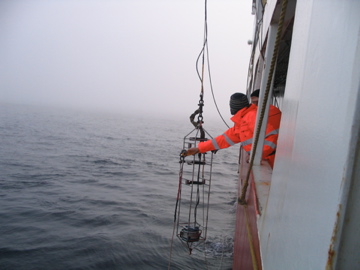 Phil’s’
last experiment involves a special modification of a standard
ADCP (acoustic Doppler current profiler). At each station,
members of the crew lower the ADCP over the side and then bring
it back on board at the end of the station. The ADCP data will
provide a general sense of the currents under the ship while it’s
stopped for a station.
Phil’s’
last experiment involves a special modification of a standard
ADCP (acoustic Doppler current profiler). At each station,
members of the crew lower the ADCP over the side and then bring
it back on board at the end of the station. The ADCP data will
provide a general sense of the currents under the ship while it’s
stopped for a station.
Some of the science team are on 12 hours shifts, noon to midnight
or vice versa. Our “mud” team and a few others just go to work
whenever we’re at a mud station, no matter the time. Our group
thought we had to start work early this morning, at 12:30 AM
(after going through the night the day before). It turned out
that our stations didn’t begin until 5:30 AM, and most everyone
got a decent amount of sleep. Today’s mud stations are all during
the day, but the water stations will start again later in the day
and most likely run through the night. The science goes on pretty
much around the clock. Even when we’re not on station and
collecting data and samples, some are analyzing their data or
working with the samples they’ve collected.
July 14, 2007
 Yesterday
I spoke with Dr. Charles Gobeil, professor of aquatic
geochemistry at the University of Quebec in Quebec City. You
might remember that I mentioned his work with the box core when I
told you about Danielle Dubien, his graduate student. I got a
chance to see the box corer in action last night and this morning
at two of our five stations. The core work is part of Canada’s
Three Oceans (Atlantic, Pacific, Arctic) Monitoring Program, a
four-year IPY (International Polar year) project. In
collaboration with Robbie Macdonald at the Institute of Ocean
Sciences in Victoria, Charles’s goal is to examine the
sedimentary record on the continental margin of Canada’s three
oceans. Each year, Canada sends out two icebreakers, the Louis
St. Laurent leaves from Halifax, Nova Scotia and travels the
eastern Arctic and the Sir Wilfrid Laurier leaves from Victoria,
British Columbia to travel the western Arctic. Charles is
gathering sediment cores for the western Arctic on
Yesterday
I spoke with Dr. Charles Gobeil, professor of aquatic
geochemistry at the University of Quebec in Quebec City. You
might remember that I mentioned his work with the box core when I
told you about Danielle Dubien, his graduate student. I got a
chance to see the box corer in action last night and this morning
at two of our five stations. The core work is part of Canada’s
Three Oceans (Atlantic, Pacific, Arctic) Monitoring Program, a
four-year IPY (International Polar year) project. In
collaboration with Robbie Macdonald at the Institute of Ocean
Sciences in Victoria, Charles’s goal is to examine the
sedimentary record on the continental margin of Canada’s three
oceans. Each year, Canada sends out two icebreakers, the Louis
St. Laurent leaves from Halifax, Nova Scotia and travels the
eastern Arctic and the Sir Wilfrid Laurier leaves from Victoria,
British Columbia to travel the western Arctic. Charles is
gathering sediment cores for the western Arctic on
 this
cruise and on another Laurier cruise in September.
this
cruise and on another Laurier cruise in September.
I’ll eventually show you pictures of our coring equipment and it
will look tiny after you’ve seen the size of the box core in
today’s pictures. The goal of box coring is to get a large,
undisturbed core from the bottom of the ocean. With the core
comes a history of the ocean itself. In coastal areas, where the
sedimentation rate is high, the history may go back 200 – 300
years. In the deep ocean with an extremely low sedimentation
rate, the history might include several thousand years!
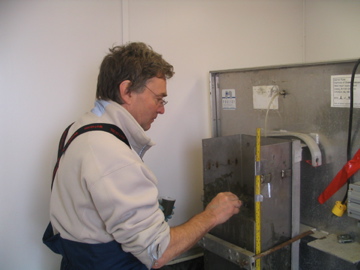
It takes Charles at least three hours to section his core (check
out the picture) starting with .5 cm sections. The entire core is
approximately 20 X 30 X 45 cm. He’ll preserve the mud to take
back for later analysis. When he analyzes the sediments, he first
dates them and them measures trace elements, isotopes, and
organic compounds in order to better understand the carbon cycle.
He’ll focus on elements sensitive to oxygen because oxygen is
consumed when decomposition of organic matter occurs. Charles’s
work compliments Jackie’s; it’s just a slightly different
approach. His cores are helpful in another way – they provide
information on contaminants. In the past 15 years, Charles has
taken 20 deep ocean cores including at the North Pole at 3500
meters. What an amazing historical record they contain!
July 13, 2007
Our mud work starts this afternoon and the station will probably
run most of the night. Since this is our first station, we’ll be
working to set things up right after lunch. I’ve spent my morning
talking to some of the other members of the science team so I can
get my journal done before we start our work.
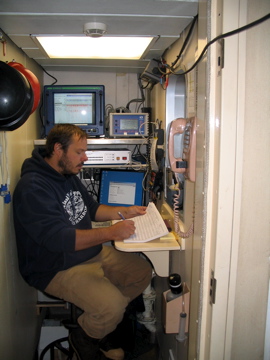
I’ve written quite a bit about the CTD and have referred to it
regularly in my journals. Today I spoke with one of the two
people who are in charge of this all important piece of
equipment. Markus Janout is originally from Germany, but is now
living in Fairbanks where he’s working on his PhD in physical
oceanography at the University of Alaska, Fairbanks. His job on
board is to run the CTD casts, to help process the data, and to
deploy the XBT every 90 minutes while the ship is underway. Let
me tell you a bit more about the CTD casts and the XBT. At each
station, Markus (or his counterpart on the noon to midnight
shift) will prepare and check the CTD bottle rosette, which is
lowered over the side with the winch. As the CTD comes up, Markus
uses the computer to “trip” (close) the bottles at different
depths to gather water. Throughout the cast, he monitors sensors
in the CTD shack (that’s where Markus is sitting in the picture).
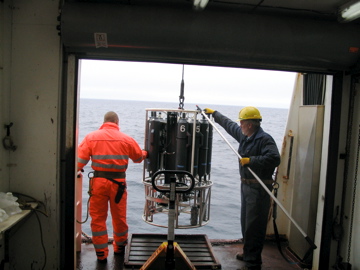 Every
90 minutes, while the ship is underway, someone will launch the
XBT (expendable bathy thermograph) off the aft deck. The
expendable part means that the device goes to the bottom and the
connecting wire is cut to release it. Once launched, the XBT
sinks to the bottom at a constant rate transmitting temperature
data vertically to depth and sending the information to a
computer on board the ship. Although the CTD provides temperature
data (and much more) while the ship is stopped, the XBT gathers
the data while the ship is running, therefore providing a much
tighter grid of temperature profiles in between CTD casts. It’s
particularly important on long transects.
Every
90 minutes, while the ship is underway, someone will launch the
XBT (expendable bathy thermograph) off the aft deck. The
expendable part means that the device goes to the bottom and the
connecting wire is cut to release it. Once launched, the XBT
sinks to the bottom at a constant rate transmitting temperature
data vertically to depth and sending the information to a
computer on board the ship. Although the CTD provides temperature
data (and much more) while the ship is stopped, the XBT gathers
the data while the ship is running, therefore providing a much
tighter grid of temperature profiles in between CTD casts. It’s
particularly important on long transects.
It’s now 8:30 PM and we’ve completed two of our five SLIP (St.
Lawrence Island polynya) stations. In the brief time between
stations, I’m going to post this journal. I promise lots of
pictures of our mud work in future journals.
July 12, 2007
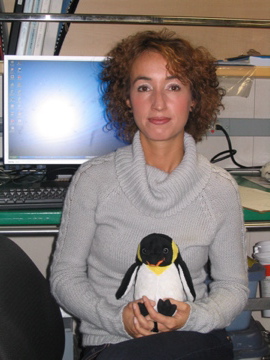 Today has been quiet so far as most of the science team is
catching some sleep after the long run of stations overnight. The
group is large this year, 17 people all working on various
projects. I’ll try to introduce you to each of them before I’m
done, and I’ll explain their work on board. Yesterday I spoke
with Sharon Edmunds who is a summer scientist, with the
Department of Fisheries and Oceans based in Ottawa. Her full time
job, also in Ottawa, is with Inuit Tapiriit Kanatami where she
serves as an advisor in social and economic development
representing the Inuit in Canada. She’s currently pursuing her
degree in environmental science at the University of the Arctic.
The University of the Arctic, a virtual university, is in the
process of designing the first ever major in climate change
studies. While on board, Sharon is responsible for data entry for
the CTD and for collecting water from the CTD for nutrients,
salinity, barium, and oxygen18 analysis. She’s also in charge of
Poasie, a small stuffed penguin. This entire year has been
designated the International Polar Year, and Poasie has been
designated the spokesperson for the educational outreach in the
polar north. A polar bear represents the polar south. The idea is
that children will recognize the travels of each animal, with the
penguin traveling north to learn and the polar bear traveling
south from its home.
Today has been quiet so far as most of the science team is
catching some sleep after the long run of stations overnight. The
group is large this year, 17 people all working on various
projects. I’ll try to introduce you to each of them before I’m
done, and I’ll explain their work on board. Yesterday I spoke
with Sharon Edmunds who is a summer scientist, with the
Department of Fisheries and Oceans based in Ottawa. Her full time
job, also in Ottawa, is with Inuit Tapiriit Kanatami where she
serves as an advisor in social and economic development
representing the Inuit in Canada. She’s currently pursuing her
degree in environmental science at the University of the Arctic.
The University of the Arctic, a virtual university, is in the
process of designing the first ever major in climate change
studies. While on board, Sharon is responsible for data entry for
the CTD and for collecting water from the CTD for nutrients,
salinity, barium, and oxygen18 analysis. She’s also in charge of
Poasie, a small stuffed penguin. This entire year has been
designated the International Polar Year, and Poasie has been
designated the spokesperson for the educational outreach in the
polar north. A polar bear represents the polar south. The idea is
that children will recognize the travels of each animal, with the
penguin traveling north to learn and the polar bear traveling
south from its home.
 This evening, after Jackie’s science talk, I spoke with three
other members of the science team and answered the question, “Why
are members of the science team throwing beer bottles over
board?” Orla Osborne, from Iqaluit, Nunavut (a territory of
Quebec) is one of the bottle “tossers.” As you might have
guessed, each bottle contains a message describing the Drift
Bottle Project and including a form to return to the Department
of Oceans and Fisheries, Institute of Ocean Sciences, British
Columbia. By comparing the location of the toss with the location
where the bottle is found, researchers hope to add to their
knowledge of large-scale ocean circulation. Orla is also a
student scientist sponsored by the Department of Fisheries and
Oceans. In addition to tossing beer bottles overboard, Orla is
helping out with the bongo nets, large nets which sample
zooplankton (small aquatic animals). I’ll tell you more about the
bongo nets one I’ve had a chance to get some pictures.
This evening, after Jackie’s science talk, I spoke with three
other members of the science team and answered the question, “Why
are members of the science team throwing beer bottles over
board?” Orla Osborne, from Iqaluit, Nunavut (a territory of
Quebec) is one of the bottle “tossers.” As you might have
guessed, each bottle contains a message describing the Drift
Bottle Project and including a form to return to the Department
of Oceans and Fisheries, Institute of Ocean Sciences, British
Columbia. By comparing the location of the toss with the location
where the bottle is found, researchers hope to add to their
knowledge of large-scale ocean circulation. Orla is also a
student scientist sponsored by the Department of Fisheries and
Oceans. In addition to tossing beer bottles overboard, Orla is
helping out with the bongo nets, large nets which sample
zooplankton (small aquatic animals). I’ll tell you more about the
bongo nets one I’ve had a chance to get some pictures.
Danielle Dubien is from Ontario and is in the first year of her
doctoral program in water science at the University of Quebec,
working with Dr. Charles Gobeil who is also on board. Both are
working with box cores, instruments that gather large chunks of
sediments from the bottom. I wasn’t on board when they did the
first cores, and they won’t do more until we get further north.
Once they do, I’ll tell you a bit more about the cores and shares
some pictures.
Corrine Warren is an undergraduate at the University of
Tennessee, Knoxville, working with Jackie. Eventually, she hopes
to earn a PhD in marine ecology. She’ll be a member of our “mud
team” but, since our work doesn’t start until this afternoon,
she’s been collecting water for nutrients, barium, oxygen 18, and
salinity during the first part of the trip. Her time on the ship
is partially funded through a UT scholarship program and she will
fulfill the program requirements, by doing her own research
project while on board. When we collect our samples, she’ll take
sub samples for analysis and for comparison with past work.
July 11, 2007
Throughout the day today, crew and science team members could be
found decorating Styrofoam cups with assorted colors of
waterproof markers. All was in preparation for the CTD cast at 6
PM when the cups, stuffed with paper towels to hold their shape
and secured in mesh bags, descended to a depth of 3000 meters
attached to the CTD rosette. You know that feeling of pressure
in your ears that you get when you dive even ten feet into a
swimming pool? Imagine what the pressure is like at 3000 meters
below the surface! Check out the pictures for today to see what
happens to a "normal" Styrofoam cup subjected to that pressure.
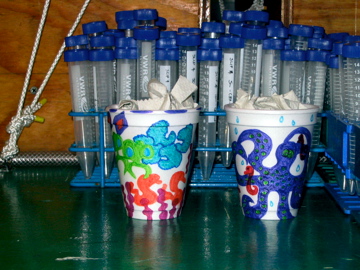 Here's what the cups look like before they've gone down to 3000 meters |
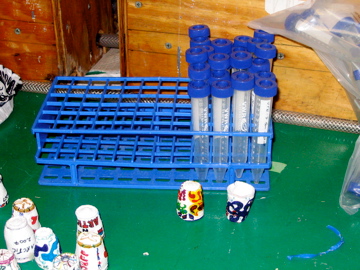 These are the same cups after going down to the bottom at 3000 meters |
The CTD collects data
on conductivity, temperature, and depth and sends it all back to
a computer. It's attached to a frame that contains twelve
water-sampling bottles arranged in a circle, and the whole
apparatus is often referred to as the CTD rosette. Each of the
bottles is open when the CTD is lowered over the side. When the
bottles trigger (close) at different depths they collect the
water from that depth. Once the rosette is at the surface,
members of the science team take turns getting water samples from
each of the bottles. The CTD itself actually collects the best
data on the way down when the water is undisturbed by the
rosette.
Everyone was excited to see what had happened to their cups, but
many had to wait until they had collected their water or, in the
case of the crew, until they were off duty. And, for the science
team, the work had just begun. The PM CTD cast was at the
first station of a line of seven stations across the Bering Sea.
The first station started at 6 PM on yesterday, and the last
ended at 8:45 this morning. Some on the science team are on
twel ve-hour shifts, but others are working alone and must stay up
for all of the stations. One of those people is Dr. Peter Lee.
Peter is originally from New Zealand, but he's now doing
postdoctoral work in biogeochemistry at the College of Charleston
in South Carolina. When the CTD is deployed, Peter will collect
water for vertical sampling and, when the ship is underway, he'll
use the ship's seawater pumping system to collect water for
horizontal sampling. He filters the water and takes the frozen
samples back to South Carolina for analysis. He's sampling for
DMSP (dimethylsulfoniopropionate), a substance found in the cells
of phytoplankton (tiny plants found in the water) and for the
pigments found in phytoplankton. DMSP not only helps the
phytoplankton regulate salt (it's an osmoregulator), it's also a
cryoprotectant (it helps them survive in cold
weather) and it's an antioxidant.
ve-hour shifts, but others are working alone and must stay up
for all of the stations. One of those people is Dr. Peter Lee.
Peter is originally from New Zealand, but he's now doing
postdoctoral work in biogeochemistry at the College of Charleston
in South Carolina. When the CTD is deployed, Peter will collect
water for vertical sampling and, when the ship is underway, he'll
use the ship's seawater pumping system to collect water for
horizontal sampling. He filters the water and takes the frozen
samples back to South Carolina for analysis. He's sampling for
DMSP (dimethylsulfoniopropionate), a substance found in the cells
of phytoplankton (tiny plants found in the water) and for the
pigments found in phytoplankton. DMSP not only helps the
phytoplankton regulate salt (it's an osmoregulator), it's also a
cryoprotectant (it helps them survive in cold
weather) and it's an antioxidant.
Peter analyzes each sample two ways. First he uses HPLC (high
performance liquid chromatography) to identify the pigments and
therefore the groups of phytoplankton. Anyone who has seen leaves
change color in the fall knows that, when chlorophyll dies back,
the additional pigments, called accessory pigments, in the leaves
show up. Just as you can identify the type of tree by the fall
color, you can identify the major groups of phytoplankton by
their pigments. Peter will be able to identify how the groups of
phytoplankton over the years due to climate change. For example,
he might see a greater concentration of some species or even a
new species moving in. That's exactly what happened when there
was an algal bloom (large production) of a non-native species of
phytoplankton in the Bering Sea between 1987 and 2002. Scientists
believe a warming trend might have made conditions favorable for
the new species.
Peter also analyzes DMSP concentrations in each sample using gas
chromatography. By looking at this data along with the pigment
analysis, he can evaluate how the DMSP concentration responds to
the changing phytoplankton community. Since this is his seventh
year of sampling at these same stations, Peter is developing a
baseline for DMSP concentration and for the phytoplankton
present.
Most people want to know how this relates to climate change. If
climate change means warming temperatures, there will likely be
additional phytoplankton production and therefore, more DMSP
production. When the phytoplankton die and release DMSP, it's
broken down by bacteria into DMS (dimethylsulfide) which is
transferred from the ocean to the atmosphere. Once in the
atmosphere, DMS is converted by sunlight to sulfate which is
critical to cloud formation. So it looks like this: warmer
temperatures, more phytoplankton, more DMSP, more DMS and
sulfates, more clouds, more cloud cover, an increase in the
Earth's albedo (ability to reflect back the sun's rays), and
cooler temperatures. Just possibly, the ocean's phytoplankton
could help to regulate the Earth's climate.
July 10, 2007
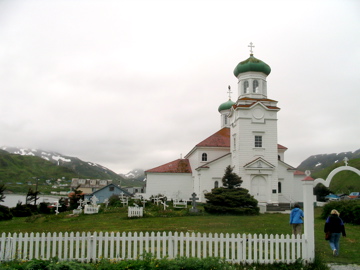
I actually arrived in
Dutch Harbor, Alaska, on Saturday, July 7 along with Dr. Jackie Grebmeier and Dr. Lee Cooper, but the Sir Wilfrid Laurier didn't
come into the harbor until early this morning. By the time it
came in, those on board were ready to spend some time on land.
For many, the first stop was Alaska Ship Supply to buy heavy-duty
hooded sweatshirts that are remarkably warm and practical for
time on the ship. I'm sure they'll show up in at least one of my
photos. After that, it was time to tour the area. Although many
recognize the name, Dutch Harbor, from the television series,
"The Deadliest Catch, Dutch Harbor is, officially, the
International Port of Dutch Harbor in the city of Unalaska. The
area is rich in culture and history. Nearly nine thousand years
ago the Unangan people, ancestors of the Aleuts settled here and
throughout the Aleutian Islands, and the Unangan settlements were
among the most powerful in the eastern Aleutians when the Russian
explorers arrived in 1759. One stop on the "tour" was the
Russian Orthodox Cathedral of the Holy Ascension. Built in
1896 and extensively renovated in 1996, the cathedral is the
oldest in Alaska.
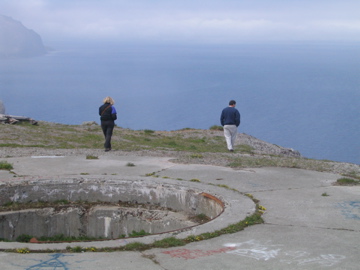
During World War II,
the Japanese invaded the Aleutian Islands, and they bombed Dutch
Harbor on July 3 and 4, 1942. Following the attacks, the U.S.
government evacuated nearly 900 residents of the Aleutian and the Pribilof Islands to Southeast Alaska where many lived in poor
conditions until the end of the war. In Dutch Harbor the army
built Fort Schwatka on Mt. Ballyhoo overlooking Dutch Harbor.
The remains of the fort and the gun mounts are now part of the
Aleutian World War II National Historic Area.
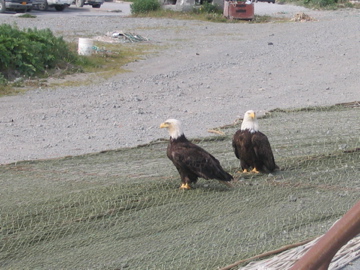
Today Unalaska and the
International Port of Dutch harbor have become a destination for
birders and fishers. During our stay in Dutch Harbor, we
regularly saw bald eagles - on lampposts, on fishing nets, and
soaring over the water, and signs of the active commercial
fishing industry are everywhere.
By 3 PM the ship had
sailed and by 4 PM, Jackie held her first science team meeting.
She'll be acting as Chief Scientist for this portion of the
cruise, and it was important for her to meet everyone and to sort
out the science plan. My fifth cruise with Jackie was underway!
Note: Much of my
information for this journal is from the "Aleutian World War II
National Historic Area 2007 Calendar" and the "Unalaska/Dutch
Harbor 2006 Official Visitors Guide."